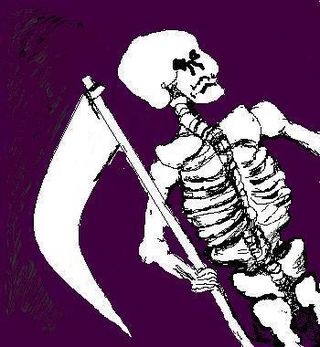A formidable character, steeped in the legends of many cultures, under different
names, is known as Ankou in Brittany; and plays a strong part in its folklore.
This
reaper of souls pervades; not only as a creature of fantasy into the Breton
culture, but once represented more than just a figment of people’s imagination.
He is even distinguished enough to appear amongst the effigy’s of saints in
Ploumilliau (a village in North West Brittany) church; a tangible reminder of
the strong beliefs of a bygone time. But with a host of other bogey-men to
choose from why choose Ankou?
Anatole
le Braz was a late nineteenth century early twentieth century collector and
translator of Breton stories and songs. Not only do they provide cosy fireside
reading but they also allow us to be privy to a way of life in Breton
communities, burdened by strong superstitious influences.
Ankou,
like Thanatos, its Greek counterpart and the Grim Reaper in medieval Christian
folklore, is usually the spirit of the last person to die in a community and
becomes the harbinger of death. So ingrained is the character of Ankou in
Breton culture even his origins have taken on a religious link; as in one fable
relating him to Adam and Eve, Ankou being their first born.
Traditionally,
the Ankou is portrayed as a tall male figure, emaciated or skeletal, in a wide
brimmed hat with long flowing white hair. But there is another version of his
appearance (even less appealing) and that is of a skeleton with a revolving head;
not a creature one would like to meet on a dark night! And that is the very
essence of the version of the story I came to hear first hand.
with long flowing white hair. But there is another version of his
appearance (even less appealing) and that is of a skeleton with a revolving head;
not a creature one would like to meet on a dark night! And that is the very
essence of the version of the story I came to hear first hand.
Fortunately
(or unfortunately, depending on your point of view) there is a representation
in wood of Ankou on display amongst those of saints in Ploumilliau village
church. A local historian enlightened me
as to why this tale had been perpetuated for so long and, as is more often the
case with ghost stories, there is a more earthly reason for the gruesome tale.
The
coast around Brittany; dotted with many bays, estuaries and inlets was
ideal for the smuggling of contraband goods. Carried inland by the plunderers
it would be necessary to hide their hoard in villages far from the prying eyes
of the customs officers. (Les douanes) The
best way to keep the villagers inside their homes with their windows shuttered
was to spread fear and what better way in a superstitious community than to
propagate the tale of Ankou.
As
time went on the stories of Ankou became more and more elaborate, introducing
into the tales two spectral helpers; whose job was to toss the dead into his
cart. His cart or death-wagon, piled
high with corpses is pulled sometimes by one but more often two horses; one
sprightly but the other starved and poorly. The citizens of the villages were
warned by the church hierarchy to beware if Ankou should rein in his horses at
their door for it meant certain death for all within!
Therefore,
when night fell all good villagers stayed inside their homes behind shuttered
window and bolted doors biding the passing of the night. While outside the smugglers scurried by
unhindered; carrying their trunks and sacks of valuables often to be hidden within
the churches. Hence Ankou’s pride of
place!
with long flowing white hair. But there is another version of his
appearance (even less appealing) and that is of a skeleton with a revolving head;
not a creature one would like to meet on a dark night! And that is the very
essence of the version of the story I came to hear first hand.
Recent Comments